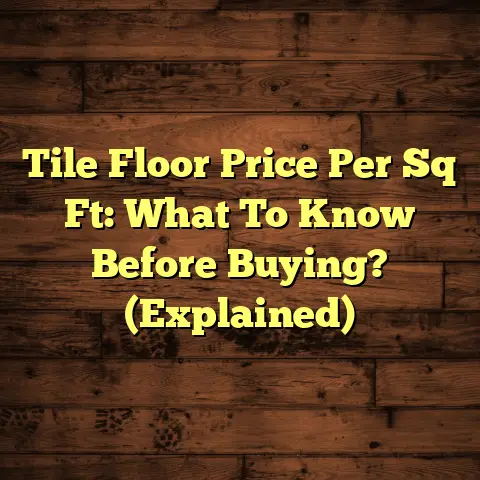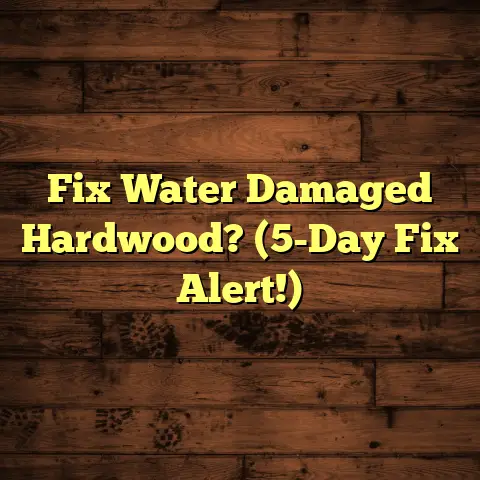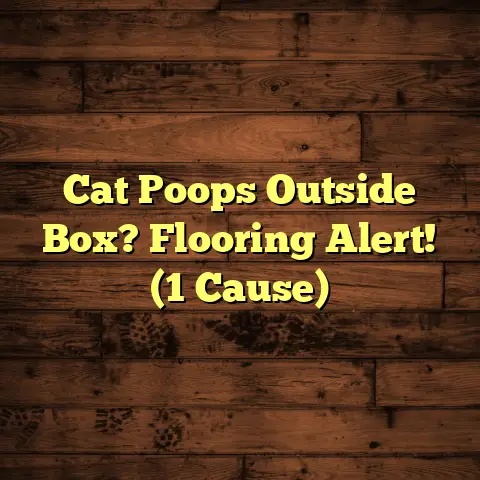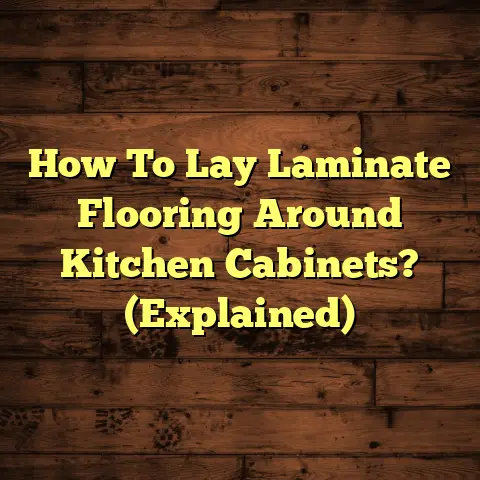Fixing Squeaky Floors In Old Homes? (1 Trick Pro’s Use!)
“Squeaky floors are more than just an annoyance; they are a sign of the history and character of a home. But they don’t have to be a permanent fixture in your living space.” – Bob Vila, Home Improvement Expert
Let’s talk about something we all secretly (or not so secretly) dread: squeaky floors. Especially in those beautiful, character-filled older homes.They tell a story, sure, but sometimes that story is a constant, irritating creak-creak-creak with every step!
As a flooring contractor for over 20 years, I’ve seen (and heard!) my fair share of squeaky floors. I’m going to share the secrets I use to silence those noisy nuisances.
We’ll dive into why they happen, the impact they have, and, most importantly, how to fix them, including that one trick pros like me swear by. Ready to get started?
Section 1: Understanding Squeaky Floors
1. What Causes Squeaky Floors?
Think of your floor as a giant puzzle. Over time, pieces shift.
Squeaks are usually caused by friction – two surfaces rubbing together.
In the case of floors, it’s often the floorboards rubbing against each other, the subfloor, or the joists (those horizontal beams supporting the floor).
Here’s a breakdown of the usual suspects:
-
Loose Floorboards: The most common culprit. Nails or screws loosen over time, allowing the boards to move and rub.
-
Inadequate Support: Joists might be spaced too far apart, causing the floor to flex and squeak.
-
Wood’s Natural Movement: Wood expands and contracts with changes in humidity and temperature. This can loosen fasteners and create gaps.
-
Subfloor Issues: A damaged or poorly installed subfloor can contribute to squeaks.
Humidity plays a big role. High humidity causes wood to expand, potentially tightening things up temporarily. But when it dries out, the wood shrinks, creating gaps and loosening fasteners.
Think of it like this: a wooden door that sticks in the summer but has a gap in the winter. Same principle!
Here’s a table showing ideal humidity levels for wood floors:
| Wood Type | Ideal Humidity Range | Potential Issues if Outside Range |
|---|---|---|
| Hardwood (Oak, Maple) | 30-50% | Cracking, warping, squeaking |
| Pine | 35-55% | Excessive expansion/contraction |
| Engineered Wood | 30-60% | Delamination, instability |
Source: National Wood Flooring Association (NWFA)
2. The Anatomy of Floorboards
Let’s break down what’s under your feet:
-
Finish Flooring: This is the top layer you see – hardwood, laminate, tile, etc.
-
Subfloor: Usually plywood or OSB (Oriented Strand Board), it provides a stable base for the finish flooring.
-
Joists: These are the horizontal beams that support the entire floor structure. They’re typically made of wood but can also be steel.
Imagine the finish flooring as the pretty face, the subfloor as the foundation, and the joists as the bones.
If any of these components are weak, damaged, or improperly connected, you’re likely to hear some squeaks.
The finish floor is attached to the subfloor, which in turn, is attached to the joists. When you walk, the weight causes slight movement.
If the connections are loose, that’s where the squeak comes from. It’s the sound of those surfaces rubbing together.
3. Common Types of Flooring in Older Homes
Older homes often feature solid hardwood, particularly oak, pine, or maple.
You might also find some older engineered wood or even linoleum (though that’s less likely to cause squeaks).
-
Hardwood: Durable and beautiful, but prone to expansion/contraction with humidity changes. This is a big factor in squeaking.
-
Pine: Softer than oak or maple, so it can be more susceptible to wear and tear, leading to loose boards.
-
Engineered Wood: More stable than solid hardwood, but still can squeak if not properly installed or if the subfloor is uneven.
The material itself affects the likelihood of squeaking. Hardwoods are generally more dimensionally stable than softwoods like pine, meaning they’re less likely to expand and contract dramatically.
However, even the best hardwood will squeak if the installation is poor.
Section 2: The Impact of Squeaky Floors on Homeowners
1. Emotional and Psychological Effects
Let’s be honest, squeaky floors are annoying. It’s like a tiny gremlin is following you around, constantly complaining.
It can disrupt your peace of mind, especially if you’re trying to relax or concentrate. I’ve had clients tell me they avoid certain areas of their house just to escape the noise!
Imagine trying to have a quiet evening at home, but every time someone walks across the living room, creak, creak, creak.
Or picture having guests over and being constantly self-conscious about the noise.
It can definitely impact your enjoyment of your home and create unnecessary stress.
It’s not just about the noise itself, it’s the constant reminder that something is not quite right with your home.
2. Potential Structural Concerns
While most squeaks are just a nuisance, they can sometimes indicate a more serious underlying problem.
Think of it as your house trying to tell you something. It’s important to pay attention.
A persistent squeak in the same spot could mean a loose joist, a damaged subfloor, or even a failing support beam.
Here are some warning signs to watch out for:
-
Excessive Bounciness: If the floor feels unusually bouncy in a specific area, it could indicate a weakened joist.
-
Visible Sagging: If you can see a noticeable dip in the floor, that’s a red flag.
-
Cracks in Walls or Ceilings: These can be a sign of structural movement, which could be related to floor problems.
-
New or Worsening Squeaks: If the squeaks are getting louder or more frequent, it’s time to investigate.
If you notice any of these signs, it’s best to call in a professional to assess the situation.
It’s better to be safe than sorry when it comes to structural issues.
Ignoring a problem can lead to more extensive (and expensive) repairs down the road. I’ve seen situations escalate to the point where entire sections of flooring needed to be replaced because a simple squeak was ignored for too long.
Section 3: The Professional’s Secret Trick
1. Introduction to the Trick
Alright, here’s the secret weapon pros use to silence squeaky floors: powdered graphite lubricant.
It’s simple, effective, and often less invasive than other solutions.
Why do we favor this? Because it’s dry, it won’t damage the wood, and it penetrates small spaces to reduce friction.
Think of it as WD-40, but for wood.
Unlike some liquid lubricants, powdered graphite won’t attract dirt or grime, and it won’t cause the wood to swell.
It’s also relatively inexpensive and easy to apply.
2. Detailed Instructions on Implementing the Trick
Here’s how to use powdered graphite to fix squeaky floors:
Step 1: Identify the Squeak
This might seem obvious, but it’s crucial to pinpoint the exact location of the squeak.
Walk around the area and have someone listen to help you isolate the spot.
Mark the squeaky area with a pencil or piece of tape.
Step 2: Prepare the Area
Clean the area around the squeak with a dry cloth.
You want to remove any dust or debris that could interfere with the graphite.
Step 3: Apply the Graphite
This is the tricky part. You need to get the graphite between the floorboards.
-
Option 1 (Best for Narrow Gaps): Use a small squeeze bottle with a pointed nozzle. Fill it with the powdered graphite and carefully puff it into the gap between the boards.
-
Option 2 (For Wider Gaps): Use a small paintbrush to apply the graphite to the edge of the squeaky board. Then, gently tap the board with a rubber mallet to work the graphite into the gap.
-
Option 3 (If you can access from below): If you have access to the floor joists from below (e.g., in a basement), you can apply the graphite directly to the underside of the floorboards where they meet the joists.
Step 4: Work it In
Walk across the area several times to help the graphite work its way into the gaps.
You might need to repeat the application a few times to completely silence the squeak.
Step 5: Clean Up
Wipe away any excess graphite with a clean, dry cloth.
Graphite can be messy, so be careful not to get it on your clothes or furniture.
Safety Tips:
- Wear a dust mask to avoid inhaling the graphite powder.
- Work in a well-ventilated area.
- Keep graphite away from children and pets.
Tools You’ll Need:
- Powdered graphite lubricant
- Small squeeze bottle or paintbrush
- Rubber mallet (optional)
- Dry cloth
- Dust mask
Testing the Floor:
After applying the graphite, walk across the area again to see if the squeak is gone.
If it’s still there, repeat the application process.
Sometimes it takes a few tries to completely silence the squeak.
Why this works:
The graphite acts as a dry lubricant, reducing friction between the floorboards and the subfloor or joists.
It’s a simple and effective way to address the root cause of the squeak without resorting to more invasive measures.
Section 4: Alternative Solutions for Squeaky Floors
While powdered graphite is a great first step, sometimes you need to bring out the big guns.
Here are some alternative solutions for more stubborn squeaks:
1. Screwing Down Loose Floorboards
This is a classic fix for loose floorboards.
How to do it:
- Locate the loose board: Identify the board that’s causing the squeak.
- Pre-drill holes: Drill pilot holes through the floorboard and into the joist below. This will prevent the wood from splitting.
- Drive in screws: Use wood screws that are long enough to penetrate the joist by at least an inch.
- Countersink the screws: Make sure the screw heads are flush with the surface of the floorboard. You can use a countersink bit to create a recess for the screw heads.
- Fill the holes: Fill the screw holes with wood filler that matches the color of your floor.
- Sand and finish: Sand the filled holes smooth and apply a finish to match the surrounding floor.
Tips for success:
- Use screws that are specifically designed for wood flooring.
- Don’t over-tighten the screws, as this can damage the wood.
- If you’re not comfortable drilling into your floor, consider hiring a professional.
2. Using Shims for Floor Support
Shims are thin pieces of wood or plastic that can be used to fill gaps between the joists and the subfloor.
This can provide additional support and reduce squeaks.
How to do it:
- Locate the gap: Identify the gap between the joist and the subfloor.
- Insert the shim: Gently tap the shim into the gap using a hammer.
- Trim the shim: Use a utility knife to trim the shim so that it’s flush with the joist.
- Secure the shim: You can use construction adhesive to secure the shim in place.
Tips for success:
- Use shims that are the correct thickness for the gap.
- Don’t force the shim into the gap, as this can damage the floor.
- If you’re not sure how to use shims, consider hiring a professional.
3. Adding a Support Beam or Sister Joists
This is a more involved solution that’s typically used for more serious structural issues.
Adding a Support Beam:
This involves installing a new beam underneath the floor to provide additional support.
This is usually done when the existing joists are too far apart or are not strong enough to support the load.
Sistering Joists:
This involves adding new joists alongside the existing joists to reinforce them.
This is usually done when the existing joists are damaged or weakened.
Important Note:
These solutions are best left to professionals.
They require specialized knowledge and tools, and it’s important to ensure that the work is done correctly to avoid further damage to your home.
Section 5: Maintenance Tips to Prevent Future Squeaks
Prevention is always better than cure! Here’s how to keep those squeaks at bay:
1. Regular Floor Inspections
Take some time every few months to walk around your house and listen for any new or worsening squeaks.
Look for signs of loose boards, sagging, or cracks.
The earlier you catch a problem, the easier it will be to fix.
2. Controlling Humidity Levels
Maintaining consistent humidity levels in your home can help prevent wood from expanding and contracting excessively.
Use a humidifier in the winter and a dehumidifier in the summer to keep the humidity within the ideal range for your flooring type (see the table in Section 1).
3. Choosing the Right Cleaning Products
Avoid using harsh chemicals or excessive water when cleaning your floors.
These can damage the wood and contribute to squeaks.
Use a cleaning product that’s specifically designed for your type of flooring.
Bonus Tip:
Consider using felt pads under your furniture legs to prevent scratches and reduce friction on the floor.
Conclusion: Bringing Silence to Your Home
Squeaky floors are a common problem in older homes, but they don’t have to be a permanent fixture.
By understanding the causes of squeaks and using the right techniques, you can silence those noisy nuisances and restore peace and quiet to your home.
Remember that professional’s trick: powdered graphite lubricant. It’s often the simplest and most effective solution.
And don’t forget to perform regular maintenance to prevent future squeaks.
Addressing squeaky floors is not just about comfort, it’s also about maintaining the integrity of your home.
So, take action today and enjoy a quieter, more peaceful living space!
Do you have any questions about fixing squeaky floors? Let me know in the comments below!





